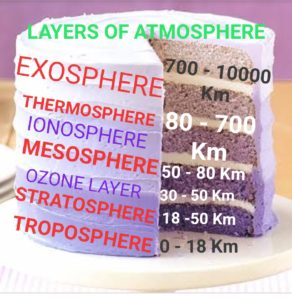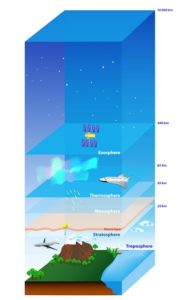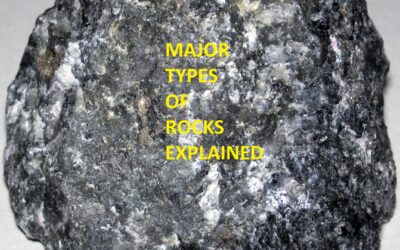ATMOSPHERIC LAYERS

ATMOSPHERIC LAYERS OF EARTH
In my previous post I shared how the earth got it’s atmosphere. Imagine earth without atmospheric layers. Can we expect life on earth without these atmospheric layers . Of course not. The atmosphere is divided into five different layers. These divisions are on the basis of temperature changes and altitude (height). https://mycbseguide.com/blog/ncert-solutions-for-class-7-social-science-geography-air/There are two simple ways to remember the atmospheric layers.
i) One of the easiest ways to remember the layers of atmosphere is just to remember E T M (O S) T where
E stands for Exosphere, T stands for Thermosphere, M stands for Mesosphere, (O & S) stands for ozone which is a part of Stratosphere and T stands for Troposphere.
ii) Another way to learn the layers of atmosphere is to remember TRUST ME IN THE EXAM where
TR stands for Troposphere, ST stands for Stratosphere, ME stands for Mesosphere, ( IN for Ionosphere), TH for Thermosphere and EX for Exosphere.
So what are the major five atmospheric layers?
- Troposphere
- Stratosphere
- Mesosphere
- Thermosphere and
- Exosphere.
LAYERS OF ATMOSPHERE:

ATMOSPHERIC LAYERS
On the earth there are total three spheres. They are Lithosphere, Hydrosphere and Atmosphere. The blanket of air that surrounds our earth is called the earth’s atmosphere. https://shapingminds.in/जापान-में-भूकंप-ज्वालामु/ The place where these spheres meet is called Biosphere. In this post we will know one by one about different layers of atmosphere.
TROPOSPHERE:
i) It is the layer nearest to the earth’s surface.
ii) this layer is approximately 8 km high at poles and about 18 km at the equator because the temperature on equator is high and the air rises higher on equator than the poles.
iii) As we move away from the equator the temperature decreases. It means temperature decreases with increase in height.
iv) Most of the weather phenomenon takes place in this layer only e.g. clouds formation, cyclones, rainfall etc.
v) with an ascent of every 165 m, the temperature decreases by 1°c in this sphere.
vi) The part where the troposphere ends and stratosphere starts is called TROPOPAUSE
STRATOSPHERE:
i) it extends up to a height of 50 km
ii) this zone is free from clouds and other weather phenomenon, therefore ideal for flying aeroplanes.
iii) ozone layer is found in this layer as we move high.
iv) this layer absorbs ultra violet rays coming from sun and protects earth from radiation.
v) due to the presence of ozone layer, https://shapingminds.in/ozone-depletion-…bal-warming-2020/ the temperature increases making this layer hot.
MESOSPHERE:
I have used blue colour for this layer. Can you guess why? Because…………
i) it is the coldest of all the atmospheric layers.
ii) it extends from 50 km to 80 km from the surface of earth.
iii) with increase in altitude, the temperature drops.
iv) at around 80 km the temperature may reach up to -100° Celsius.
v) one interesting fact about this layer is that the meteors burn as it enters here. The meteors easily pass through exosphere and thermosphere because of no air but as it enters Mesosphere, it catches fire due to friction from the gases present. The coldest layer where the meteors burn, isn’t it interesting.
THERMOSPHERE:
i) it extends from 80 km to 700 km.
ii) International space stations are located in this layer.
iii) X rays and Ultraviolet radiations are absorbed in the atmosphere.
iv) temperature increases with height. The temperature may go up to more than 1000° C in the day time.
v) high temperature makes the particles in the atmosphere electrically charged causing aurora.
vi) it reflects radio , t.v. and FM signals.
vi) The most interesting fact about Thermosphere is in spite of extremely high temperature (about 1000° C) the air here is freezing cold.
EXOSPHERE:
I) Outermost layer of the earth.
ii) extends from 700 km to 10,000 km
iii) most of the satellites orbit here.
iv) Mostly Hydrogen and Helium is found here.
v) Aurora lights can be seen here also.
QUESTIONS RELATED TO LAYERS OF ATMOSPHERE:
Q.1) The lowest layer from the earth’s surface is_____________
a) Troposphere
b) Stratosphere
c) Thermosphere
d) Mesosphere
Q.2) The maximum height of troposphere near the poles is __________
a) 6 km
b) 8 km
c) 10 km
d) 18 km
Q.3) The temperature decreases by 1°C in Troposphere with an increase in height of
a) 126 m
b) 156 m
c) 651 m
d) 165 m
Q.4. The part where the troposphere ends and stratosphere starts is called _______________
a) upper Troposphere
b) Tropopause
c) Aurora
d) Polar Troposphere
Q.5) Stratosphere extends up to a height of _______________km
a) 18 km
b) 34 km
c) 50 km
d) 62 km
Q.6) The most ideal sphere for flying aeroplanes is ________________
a) Troposphere
b) Stratosphere
c) Mesosphere
d) Thermosphere
Q.7) In which sphere Ozone layer depletion is seen?
a) Mesosphere
b) Ionosphere
c) Thermosphere
d) Stratosphere
Q.8) When was the first Ozone hole discovered?
a) 1888
b) 1945
c) 1970
d) 1990
Q.9) The depletion in the Ozone layer is mainly caused by
a) Chloro Fluorocarbon
b) Carbon di oxide
c) Carbon mono oxide
d) Methane
Q.10) Which is the coldest layer of atmosphere?
a) Mesosphere
b) Ionosphere
c) Thermosphere
d) Stratosphere
Q.11) What will be the colour of sky if there were no atmosphere? (NTSE)
a) White
b) Blue
c) Black
d) Red
Q.12) Which is the warmest layer of the atmosphere?
a) Thermosphere
b) Stratosphere
c) Mesosphere
d) Troposphere
Q.13) The meteors easily pass through Exosphere and Thermosphere because of no air but as it enters ____________ it burns.
a) Ozonosphere
b) Mesosphere
c) Ionosphere
d) Thermosphere
Q.14) International space stations are located in ___________
a) Ionosphere
b) Mesosphere
c) Ozonosphere
d) Thermosphere
Q.15) Satellites orbit in _____________ layer.
a) Thermosphere
b) Ionosphere
c) Mesosphere
d) Exosphere
ANSWER KEY:
1 a) Troposphere 2. b) 8 km 3. d) 165 m 4. b) Tropopause 5. c) 50 km 6. b) Stratosphere 7. d) Stratosphere
8. c) 1970 9. a) Chloro Fluorocarbon 10. a) Mesosphere 11. c) Black 12. a) Thermosphere 13. b) Mesosphere
14. b) Mesosphere 15. d) Exosphere




0 Comments